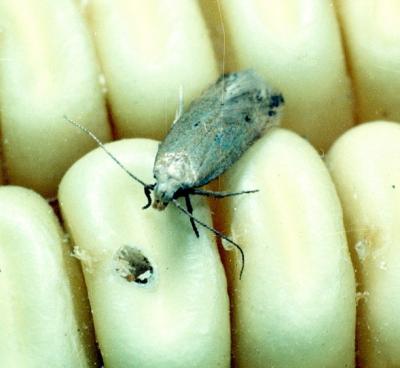

Angoumois grain moth (Sitotroga cerealella)
The larvae of the Angoumois grain moth penetrate and feed inside maize grain. This insect may also infest the crop in the field prior to harvest. The moths are small (nearly 1 cm long) yellowish or straw-coloured, a have a fringe along the posterior margins of the wings. They can be observed flying around infested stores.
Female moths lay eggs at night. Eggs are laid singly or in clumps on the outside of cereal grains, in cracks, grooves or holes made by other insects. Eggs are initially white turning red near hatching. The larvae are whitish. The larvae prepare a round exit hole for the moth, leaving the outer seed wall only partially cut as a flap over the hole, resembling a trap door. The adult pushes its way out through this "window" leaving the trap door hinged to the grain. Infested grains can be recognised by the presence of these small windows. The adult lifespan may be up to 15 days, and 1 female can lay over 100 eggs.
- Practise store hygiene. All residual pockets of infestation should be cleaned out at the end of the storage season. This is important to minimise re-infestation of the new crop.
- Store old and new lots separately.
- Do not leave maize in the field after drying, this increases the chances of infestation.
- Whenever possible separate stores from fields. The grain moths are good flyers and adults from infested stores often infest growing maize in the field.
- Keep the temperature and humidity as low as possible. There are indications that storing grain in a dry place can reduce infestation.
- Prevent pest entry by sealing the store (windows, doors, ventilation facilities) with insect-proof gauze. Hermetic storage at low humidity gives good levels of control. In Malawi, plastering stores with mud to reduce water uptake was found to be effective (Golob and Muwalo, 1984, CABI, 2000).
- Periodically inspect and remove any infested maize.
